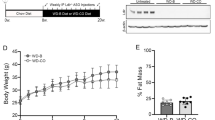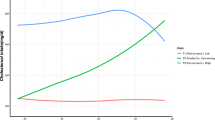Abstract
Objective: Increased HDL-cholesterol (HDL-C) concentrations have been associated with lower coronary heart disease risk. On the other hand, dietary fats are known to influence the fatty acid profile of plasma lipids, including phospholipids that are substrates of lecithin cholesterol acyltransferase (LCAT), an important enzyme in HDL metabolism. The purpose of this study was to examine the association between the saturated fatty acid (SFA) intake and LCAT activity.
Design: An interventional study was performed in a monk community of 25 men.
Setting: A French monk community, South West of France.
Subjects and interventions: The basal diet of the study cohort contained SFA in a proportion of 13.5% of their total energy intake (TEI). They were submitted to two experimental isocaloric diets containing either 8.4% of the TEI in SFA (diet A) or 11% (diet B), each lasting 5 weeks.
Results: The elevation of SFA in diet B was mainly obtained by decreasing carbohydrates. The only significant difference among total fats between diets A and B was the myristic acid content (0.6 and 1.2% of TEI, respectively). The elevation in SFA in diet B resulted in a significant increase of HDL-C (P<0.04), while plasma apo A-I concentration and LCAT activity both decreased (P<0.02).
Conclusion: Altogether, these results are consistent with a negative effect of SFA on reverse cholesterol transport.
This is a preview of subscription content, access via your institution
Access options
Subscribe to this journal
Receive 12 print issues and online access
$259.00 per year
only $21.58 per issue
Buy this article
- Purchase on SpringerLink
- Instant access to full article PDF
Prices may be subject to local taxes which are calculated during checkout

Similar content being viewed by others
References
Albers JJ, Tollefson JH, Chen CH & Steinmetz A (1984): Isolation and characterization of human plasma lipid transfer proteins. Arteriosclerosis 4, 49–58.
Baudet MF, Dachet C, Lasserre M, Esteva O & Jacotot B (1984): Modification in the composition and metabolic properties of human low density and high density lipoproteins by different dietary fats. J. Lipid Res. 25, 456–468.
Bérard AM, Foger B, Remaley A, Shamburek R, Vaisman BL, Talley G, Paigen B, Hoyt Jr RF, Marcovina S, Brewer Jr HB & Santamarina-Fojo S (1997): High plasma HDL concentrations associated with enhanced atherosclerosis in transgenic mice overexpressing lecithin-cholesteryl acyltransferase. Nat. Med. 3, 744–749.
Burr ML, Fehily AM, Gilbert JF, Rogers S, Holliday RM, Sweetnam PM, Elwood PC & Deadman NM (1989): Effects of changes in fat, fish, and fibre intakes on death and myocardial reinfarction: diet and reinfarction trial (DART). Lancet 2, 757–761.
Chen CH & Albers JJ (1982): Characterization of proteoliposomes containing apoprotein A-I: a new substrate for the measurement of lecithin: cholesterol acyltransferase activity. J. Lipid Res. 23, 680–691.
Cox C, Mann J, Sutherland W, Chisholm A & Skeaff M (1995): Effects of coconut oil, butter, and safflower oil on lipids and lipoproteins in persons with moderately elevated cholesterol levels. J. Lipid Res. 36, 1787–1795.
de Lorgeril M, Salen P, Martin JL, Monjaud I, Delaye J & Mamelle N (1999): Mediterranean diet, traditional risk factors, and the rate of cardiovascular complications after myocardial infarction: final report of the Lyon Diet Heart Study. Circulation 99, 779–785.
Dietschy JM (1998): Dietary fatty acids and the regulation of plasma low density lipoprotein cholesterol concentrations. J. Nutr. 128(Suppl), 444S–448S.
Francone OL, Gurakar A & Fielding C (1989): Distribution and functions of lecithin:cholesterol acyltransferase and cholesteryl ester transfer protein in plasma lipoproteins. Evidence for a functional unit containing these activities together with apolipoproteins A-I and D that catalyzes the esterification and transfer of cell-derived cholesterol. J. Biol. Chem. 264, 7066–7072.
Gillotte KL, Lund-Katz S, de la Llera-Moya M, Parks JS, Rudel LL, Rothblat GH & Phillips MC (1998): Dietary modification of high density lipoprotein phospholipid and influence on cellular cholesterol efflux. J. Lipid Res. 39, 2065–2075.
GISSI investigators (1999): Dietary supplementation with n-3 polyunsaturated fatty acids and vitamin E after myocardial infarction: results of the GISSI-Prevenzione TRIAL. Lancet 354, 447–455.
Glomset JA (1968): The plasma lecithin:cholesterol acyltransferase reaction. J. Lipid Res. 9, 155–167.
Grundy SM (1994): Influence of stearic acid on cholesterol metabolism relative to other long-chain fatty acids. Am. J. Clin. Nutr. 60(Suppl), 986S–990S.
Grundy SM & Denke MA (1990): Dietary influences on serum lipids and lipoproteins. J. Lipid Res. 31, 1149–1172.
Hodson L, Skeaff CM & Chisholm WA (2001): The effect of replacing dietary saturated fat with polyunsaturated or monounsaturated fat on plasma lipids in free-living young adults. Eur. J. Clin. Nutr. 55, 908–915.
Hu FB, Stampfer MJ, Manson JE, Rimm E, Colditz, GA, Rosner BA, Hennekens CH & Willett WC (1997): Dietary fat intake and the risk of coronary heart disease in women. N. Engl. J. Med. 337, 1491–1499.
Jansen S, Lopez-Miranda J, Castro P, Lopez-Segura F, Marin C, Ordovas JM, Paz E, Jimenez-Pereperez J, Fuentes F & Perez-Jimenez F (2000): Low-fat and high-monounsaturated fatty acid diets decrease plasma cholesterol ester transfer protein concentrations in young, healthy, normolipemic men. Am. J. Clin. Nutr. 72, 36–41.
Krauss RM, Eckel RH, Howard B, Appel LJ, Daniels SR, Deckelbaum RJ, Erdman Jr JW, Kris-Etherton P, Goldberg IJ, Kotchen TA, Lichtenstein AH, Mitch WE, Mullis R, Robinson K, Wylie-Rosett J, St Jeor S, Suttie J, Tribble DL & Bazzarre TL (2000): AHA Dietary Guidelines: revision 2000: a statement for healthcare professionals from the Nutrition Committee of the American Heart Association. Circulation 102, 2284–2299.
Kris-Etherton PM & Dietschy J (1997): Design criteria for studies examining individual fatty acid effects on cardiovascular disease risk factors: human and animal studies. Am. J. Clin. Nutr. 65, 1590S–1596S.
Larking PW & Sutherland WH (1977): Lecithin: cholesterol acyl transferase activity in the serum of rats fed saturated and unsaturated fats. Atherosclerosis 26, 225–232.
Le Morvan V, Dumon MF, Palos-Pinto A & Bérard AM (2002): n-3 FA increase liver uptake of HDL-cholesterol in mice. Lipids 37, 767–772.
Loison C, Mendy F, Serougne C & Lutton C (2002): Dietary myristic acid modifies the HDL-cholesterol concentration and liver scavenger receptor BI expression in the hamster. Br. J. Nutr. 87, 199–210.
Mensink RP & Katan MB (1992): Effect of dietary fatty acids on serum lipids and lipoproteins A meta-analysis of 27 trials. Arterioscler. Thromb. 12, 911–919.
Miller JP, Chait A & Lewis B (1975): The relationship between dietary fat composition and plasma cholesterol esterification in man. Clin. Sci. Mol. Med. 49, 617–620.
Miller NE, La Ville A & Crook D (1985): Direct evidence that reverse cholesterol transport is mediated by high-density lipoprotein in rabbit. Nature 314, 109–111.
Peuchant E, Wolff R, Salles C & Jensen R (1989): One-step extraction of human erythrocyte lipids allowing rapid determination of fatty acid composition. Anal. Biochem. 181, 341–344.
Riccardi G & Rivellese AA (1993): An update on monounsaturated fatty acids. Curr. Opin. Lipidol. 4, 13–16.
Romijn D, Wiseman SA, Scheek LM, de Fouw NJ & van Tol A (1998): A linoleic acid enriched diet increases serum cholesterol esterification by lecithin:cholesterol acyltransferase in meal-fed rats. Ann. Nutr. Metab. 42, 244–250.
Schaefer EJ, Levy RI, Ernst ND, Van Sant FD & Brewer Jr HB (1981): The effects of low cholesterol, high polyunsaturated fat, and low fat diets on plasma lipid and lipoprotein cholesterol levels in normal and hypercholesterolemic subjects. Am. J. Clin. Nutr. 34, 1758–1763.
Spector AA, Kaduce TL & Dane RW (1980): Effect of dietary fat saturation on acylcoenzyme A:cholesterol acyltransferase activity of rat liver microsomes. J. Lipid Res. 21, 169–179.
Stokke KT & Norum KR (1971): Determination of lecithin: cholesterol acyltransfer in human blood plasma Scand. J. Clin. Lab. Invest. 27, 21–27.
Takatori T, Phillips FC, Shimasaki H & Privett OS (1976): Effects of dietary saturated and trans fatty acids on tissue lipid composition and serum LCAT activity in the rat. Lipids 11, 272–280.
Temme EH, Mensink RP & Hornstra G (1997): Effects of medium chain fatty acids (MCFA), myristic acid, and oleic acid on serum lipoproteins in healthy subjects. J. Lipid Res. 38, 1746–1754.
Thornburg JT, Parks JS & Rudel LL (1995): Dietary fatty acid modification of HDL phospholipid molecular species alters lecithin: cholesterol acyltransferase reactivity in cynomolgus monkeys. J. Lipid Res. 36, 277–289.
Acknowledgements
We acknowledge Mrs RP Lacomère and M Bernard for collecting dietary information and for their contribution to diet analysis. We thank E Peuchant for her contribution to fatty acid analysis.
Author information
Authors and Affiliations
Contributions
Guarantor: AM Bérard
Contributors: AMB was responsible for lipoprotein metabolism analysis, determination of LCAT and CETP activities, data analysis and preparation of the paper. HD was responsible for the study design and recruiting subjects. APP was responsible for FPLC analysis and CER determination. MFD was responsible for laboratory organization and data collection. MD was responsible for preparation of the paper.
Corresponding author
Rights and permissions
About this article
Cite this article
Bérard, A., Dabadie, H., Palos-Pinto, A. et al. Reduction of dietary saturated fatty acids correlates with increased plasma lecithin cholesterol acyltransferase activity in humans. Eur J Clin Nutr 58, 881–887 (2004). https://doi.org/10.1038/sj.ejcn.1601890
Received:
Revised:
Accepted:
Published:
Issue date:
DOI: https://doi.org/10.1038/sj.ejcn.1601890



